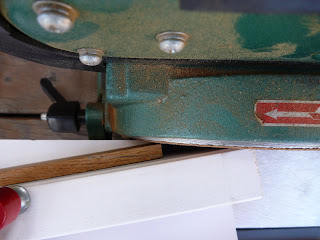Ok. So ignoring it isn't getting the job done. I keep taking furtive peeks down the backyard, but everything still looks exactly the same. It seems that the 'helpful elves' thing is a crock of shit after all. Apparently I'm the 'only' person who can make something happen. Yeah, I get it.
With this in mind, I have made some lifestyle changes and readjusted some priorities. Much has happened throughout the last year, which kept me way too busy to think about the poor canoe (other than the constant fantasies about eventually paddling/sailing her). But that's all history now. My studies are on hold, and won't be resumed until this baby is finished and in (hopefully not under) the water. Other 'life' issues are now at a point where they can be left on the back burner, and just monitored for a while. Time to focus my efforts again.
A couple of days ago, I uncovered the old girl and gave her a good clean out. Everything seems the same as when I covered her up last February.

Because the idea of whimping out (i.e. getting someone else to do my scarf joints for the gunwales) really grates on my nerves, I've decided to see if there is any way that I can do them myself. Yesterday I cleared a space on our verandah and laid out my gunwale stock. After much mental gymnastics, I came to the conclusion that I'm going to have to go see my mate (Rick) and beg for some more longer lengths. He's already done so much to help, that I'm reluctant to ask for more, but I have little choice. I have enough shorter lengths to suffice, but it would mean lots of scarf joints, resulting in a weaker structure (and lots more work/opportunity for stuff ups). At least I'll have enough longer lengths to be able to do the inner gunwales for the time being. I just need to ascertain an 'idiot-appropriate' technique for the scarf joints.

A search of the internet uncovered a likely option. It involves clamping a guide to the face plate of a stationary sanding disc, and simply sliding the stock into it until the appropriate bevel is achieved. Sounds simple.
I dug my trusty sanding machine out and set it up accordingly. Mindful of the necessity of accuracy, I spend much time trying to get the plate as level as possible. The result wasn't perfect, but as close as I could get it.

Then I measured out my scarf angle on the stock. I used a shorter length of the actual teak stock cut in half, since I'm hoping to get more anyway. The bevel should be cut to a minimum of 8:1, but I want maximum strength (and simplicity), so I opted for a 10:1 angle.
Then measuring out the angle with a plastic protractor, I transferred the angle to a piece of paper....

...then clamped my guide along the line. Then it was time to tentatively try my stock for real.

Bugga! Bastard! Bum!

It seems that those little inaccuracies add up to really screw a job. Righto, how about trying to level it out properly by eye? How hard could it be?

Hmm, that hard huh? Ok, maybe time to change tack. After a lot of swearing, tool throwing and soul searching, I had a brainstorm. I remembered I had a chisel sharpening guide, that I bought years ago (foreseeing the grand day that I might become a boatbuilder.....pwhaaaahaaahaahaa). What if I could set it up directly on the stock, and use it to control the bevelling?
After much fiddling around, what I came up with looked like this.

I tried it on the running belt part of the machine, but it was a bit too short, vibrated heaps and I worried it would munch the guide roller away in no time. I also didn't tighten the thumbscrew enough, so it started to skew diagonally.
I reset the angle and fully tightened the screw again. I also dug out the torture board, that I'd experimented with ages ago. With the board's longer length, I was able to slowly ride the assembly back and forth across the sandpaper with much more control.

By George, I think I've got it.




































